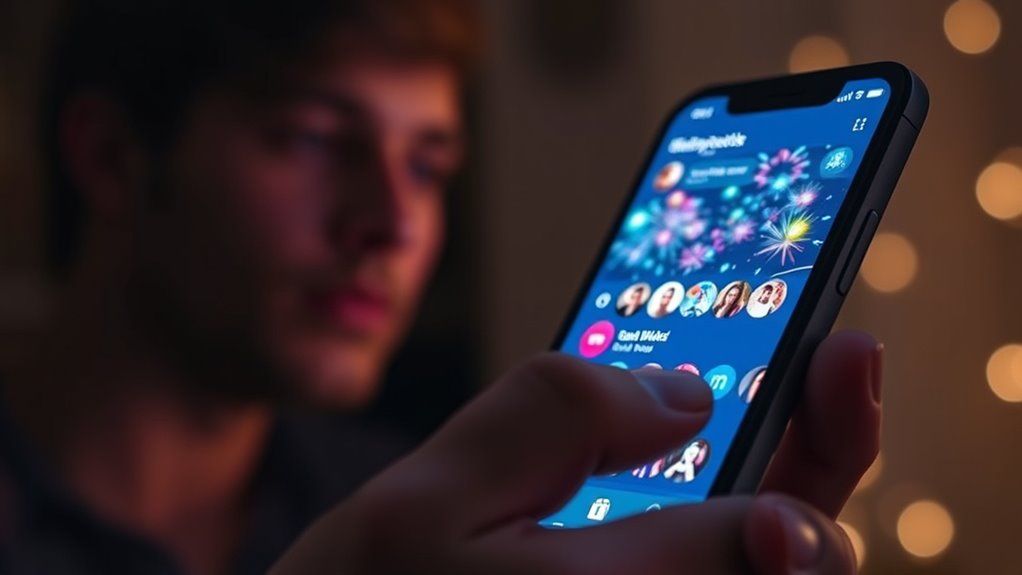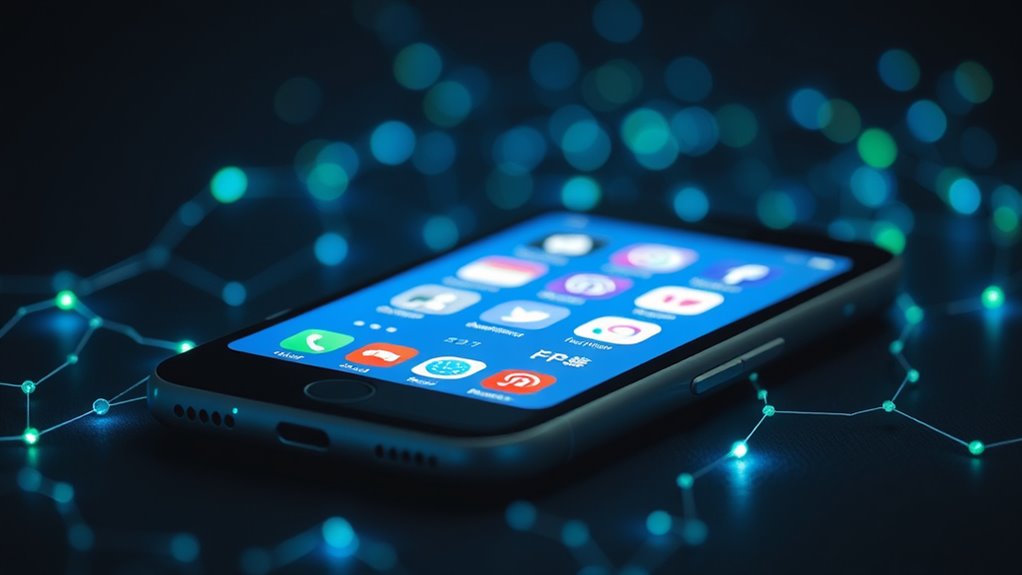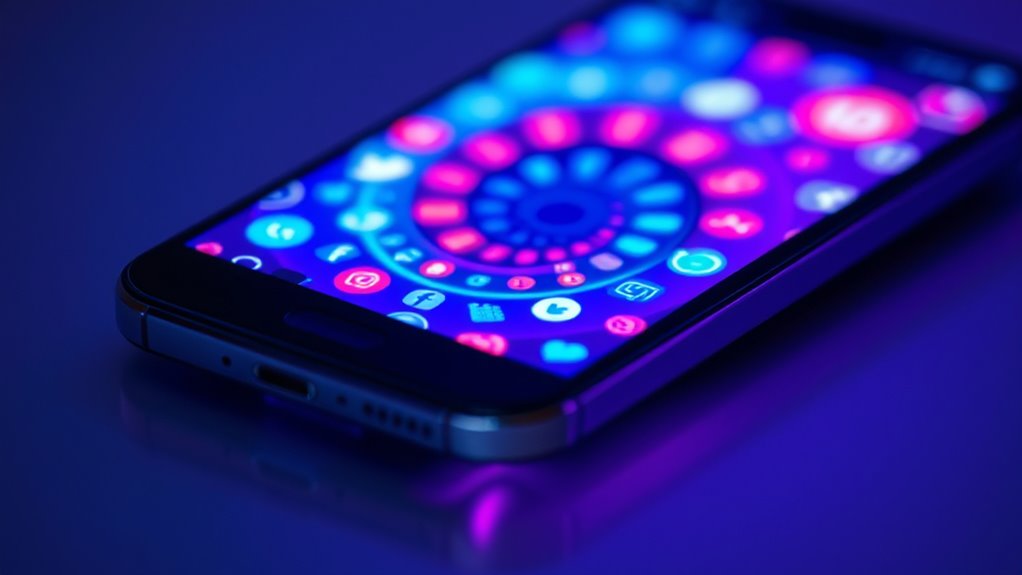Dopamine loops in social media design exploit your brain’s reward system by providing unpredictable rewards like likes, notifications, and endless content, which trigger dopamine release and keep you engaged. Features such as notifications and likes create quick bursts of pleasure, reinforcing habitual checking. These platforms use variable rewards and design tricks to make you seek more. By understanding these mechanisms, you can develop mindful habits and regain control over your digital life—if you explore further, you’ll discover how to break free.
Key Takeaways
- Social media uses unpredictable rewards like notifications and likes to trigger dopamine release, reinforcing user engagement.
- Features such as endless scrolling and instant feedback create habit loops by constantly activating the brain’s reward system.
- Variable reward schedules maintain anticipation and excitement, strengthening dopamine-driven behaviors over time.
- Algorithmic content delivery personalizes unpredictable rewards, encouraging prolonged use and reinforcing dopamine pathways.
- Awareness of these design strategies helps users develop healthier habits and mitigate addictive social media behaviors.
The Science Behind Dopamine and Reward

Dopamine is a neurotransmitter that plays a key role in how our brains experience pleasure and motivation. When you encounter something rewarding, neurotransmitter interactions activate your brain’s reward circuit, reinforcing behaviors that lead to pleasure. This process involves complex reward circuit modulation, where dopamine release signals that something is valuable, encouraging you to repeat the action. Your brain learns to associate certain cues with positive outcomes, strengthening these neural pathways. This natural mechanism motivates you to seek out rewarding experiences, from food to social interactions. Additionally, understanding how neural pathways are involved can help explain the intensity of the reward response. Furthermore, research shows that the brain’s reward system** can be influenced by behavioral patterns and external stimuli, which can either enhance or hijack your natural reward responses. The influence of attention** on these processes underscores how focused engagement can amplify dopamine release and reward perception. Understanding this science reveals how dopamine influences your drive and desire, making it central to how you learn, adapt, and feel pleasure. Recognizing these processes helps explain why certain stimuli, like social media, can hijack your reward system.
How Social Media Triggers Dopamine Release

Social media keeps you hooked by giving you instant gratification whenever you check your notifications or see new content. It also uses a variable reward system, so you’re unsure when you’ll get a big dopamine hit, keeping you engaged longer. These triggers make your brain crave more, fueling your desire to keep scrolling. Additionally, high refresh rates and low input lag in app design can optimize the quick response times that further reinforce dopamine release. As cyber threats become more sophisticated, social media platforms increasingly rely on AI security technologies to detect and prevent malicious activities that could exploit user engagement tactics. Moreover, ongoing research into AI vulnerabilities emphasizes the importance of maintaining trustworthiness and safety in these systems. Understanding how user engagement is driven by these technological factors can help users develop healthier social media habits.
Instant Gratification Triggers
When you scroll through your feed, you often find yourself rewarded with immediate bursts of pleasure that keep you hooked. This is the power of instant gratification—social media is designed to deliver quick emotional triggers that release dopamine, giving you a fleeting sense of happiness. Likes, comments, and notifications act as instant rewards, reinforcing your engagement. These triggers tap into your desire for rapid validation and connection, making it hard to stop scrolling. The brain craves these quick hits of pleasure, encouraging repeated use. Additionally, Crochet Styles for Locs often incorporate small, satisfying steps that can generate similar feelings of accomplishment and reward. Social media platforms intentionally craft these moments of instant gratification to maximize your dopamine response, ensuring you keep returning for more. Recognizing the importance of dopamine release mechanisms can help you better understand how your behavior is being influenced.
Variable Reward Systems
Variable reward systems are at the core of how social media keeps you engaged by unpredictably delivering rewards that trigger dopamine releases. These systems rely on algorithmic curation to present content unpredictably, making each visit a chance for a new reward. These algorithms often incorporate sound recording techniques to optimize content delivery, enhancing user engagement. Your engagement metrics, like likes and comments, influence what appears next, creating a cycle of anticipation and surprise. The key features include:
- Randomized Content: Algorithms select posts unpredictably, enhancing anticipation.
- Variable Timing: Notifications and updates arrive at irregular intervals, heightening dopamine release.
- Uncertain Outcomes: The possibility of a rewarding interaction keeps you hooked.
- Dog breeds and their unique traits are often showcased in social media content, further reinforcing engagement patterns. This unpredictable pattern of rewards taps into your brain’s dopamine system, encouraging continuous scrolling and engagement. Additionally, electric bikes and their capabilities are frequently featured, appealing to interests in innovative transportation. To sustain user interest, these platforms often employ AI content clusters that organize related content, making it easier to discover new and engaging posts, thereby maximizing your time spent on social media platforms. Moreover, understanding the underlying psychological principles behind these reward systems can help users develop healthier usage habits.
Design Features That Exploit Reward Pathways

Design features that exploit reward pathways are intentionally crafted to maximize user engagement by triggering dopamine release. Social media platforms use algorithm manipulation to present content that appeals to your brain’s craving for instant gratification. Features like endless scrolling, notifications, and likes keep you hooked, fueling your desire for reward. These techniques tap into your reward system, encouraging repeated interactions. However, ethical considerations come into play, as these strategies can lead to addictive behaviors and diminish well-being. By understanding how design leverages dopamine pathways, you can become more aware of how platforms influence your habits. Recognizing these features helps you make conscious choices, avoiding unintentional overuse while still enjoying social media responsibly.
The Role of Variable Rewards in User Engagement

You’re likely aware that unpredictable reward patterns keep you hooked, but social media platforms use this to their advantage. By reinforcing user behavior through unexpected rewards, they create strong engagement loops. These cycles build anticipation, encouraging you to check again and again. This manipulative design can foster a dependency on validation, making it harder to disengage. Additionally, these reward structures often exploit dopamine loops, reinforcing the cycle of continued engagement and making it difficult to break free. Recognizing how these cookie categories function can help users understand the mechanisms behind their engagement. For example, understanding the significance of preppy dog names can illustrate how certain naming trends influence perception and attachment. Incorporating vertical storage solutions and multi-functional furniture might seem unrelated, but understanding these mechanisms helps in creating healthier digital habits, similar to how decluttering promotes mental clarity and reduces stress.
Unpredictable Reward Patterns
Because social media platforms often reward users unpredictably, they tap into our natural desire for novelty and surprise to boost engagement. These unpredictable reward patterns activate emotional triggers, making interactions feel exciting and compelling. This randomness reinforces habit formation, encouraging you to keep checking for that next surprise. To understand this better: 1. The unpredictability heightens dopamine release, making each notification feel rewarding. 2. Emotional triggers like curiosity or anticipation keep you hooked. 3. The inconsistency strengthens the habit loop, making it harder to break away. Additionally, resources and tools such as targeted design principles reveal how the unpredictability of rewards can be strategically employed to enhance user experience and engagement. Recognizing the role of behavioral psychology in these patterns can help users develop healthier digital habits. Furthermore, the weight of wind turbine blades demonstrates how design choices can impact overall system efficiency, similar to how reward unpredictability influences user behavior.
Reinforcing User Behavior
Have you ever noticed how quickly you find yourself scrolling through social media, unable to stop? That’s no accident. Developers use algorithm optimization and a carefully designed user interface to reinforce your engagement. By delivering variable rewards—like a new comment, a like, or an intriguing post—they trigger dopamine releases that encourage you to keep scrolling. These unpredictable outcomes make your brain crave the next surprise, strengthening your behavior. The user interface is crafted to make these rewards easy to access and highly visible, enhancing their reinforcing power. This cycle keeps you hooked, as your brain associates checking the app with the pleasure of unexpected gains. Ultimately, these strategies create a loop that reinforces your habit, making it difficult to put your device down.
Building Anticipation Cycles
Building anticipation cycles relies on the strategic use of variable rewards to keep users engaged over time. These anticipation cycles create a sense of expectation management, making each interaction more compelling. To effectively build these cycles, consider:
- Varying reward timing to prevent predictability.
- Introducing unexpected features or content to surprise users.
- Using intermittent reinforcement to strengthen engagement.
This approach keeps users enthusiastic, as they learn to associate their actions with unpredictable but rewarding outcomes. By managing expectations through unpredictable rewards, you sustain interest and prolong engagement. The key is to balance anticipation with surprise, ensuring users stay invested without feeling manipulated. When executed well, anticipation cycles turn casual visits into habitual behaviors, reinforcing dopamine loops that keep users coming back.
The Impact of Notifications and Likes

Notifications and likes serve as powerful triggers in social media design, directly activating dopamine loops that keep you engaged. Each ping or notification taps into your desire for social validation, encouraging you to check your device repeatedly. Over time, this can lead to notification fatigue, where the constant alerts become overwhelming and less rewarding. You might find yourself craving the next like or comment, driven by the brain’s reward system. This cycle creates a feedback loop: the anticipation of social validation fuels your behavior, making it difficult to resist checking for updates. As a result, notifications and likes become central to your social media experience, reinforcing engagement through dopamine release and making breaks feel challenging.
Strategies to Break Free From Dopamine Loops

Breaking free from dopamine loops requires intentional actions to regain control over your social media habits. Developing contextual awareness helps you recognize triggers that lead to mindless scrolling. To strengthen this, consider these strategies:
- Limit daily screen time and set specific boundaries.
- Turn off non-essential notifications to reduce constant stimuli.
- Choose platforms or content that prioritize ethical design, minimizing addictive features.
Building Mindful Social Media Habits

Developing mindful social media habits involves intentionally shaping how you engage with online platforms. Start by cultivating mindful awareness of your browsing patterns—notice when you’re scrolling out of habit or boredom. Set clear boundaries, such as limiting daily usage or designating specific times for social media. Incorporate regular digital detoxes to reset your dopamine levels and reduce reliance on constant notifications. During these breaks, focus on offline activities that bring genuine fulfillment, like hobbies or face-to-face conversations. As you practice mindfulness, you’ll become more conscious of your triggers and better equipped to avoid impulsive checks. Building these habits takes effort, but over time, they help you regain control, foster healthier interactions, and create a more balanced digital life.
Frequently Asked Questions
How Do Individual Differences Affect Dopamine Responses to Social Media?
You might notice that your dopamine responses to social media vary because of personality traits and genetic predispositions. If you’re more extroverted or impulsive, you could experience stronger dopamine boosts from likes and notifications. Your genetics also play a role, influencing how your brain’s reward system reacts. These individual differences shape how intensely you seek social media validation, making some users more susceptible to dopamine-driven habits than others.
Can Understanding Dopamine Loops Help in Designing Healthier Social Media Platforms?
Did you know that 27% of users report feeling addicted to social media? Understanding dopamine loops can indeed help you design healthier platforms by balancing user engagement and digital addiction risks. By analyzing these loops, you can create features that promote positive interactions without fostering compulsive use. This knowledge empowers you to develop social media experiences that prioritize user well-being while maintaining engagement, ultimately reducing harmful digital addiction.
Are There Long-Term Psychological Effects of Dopamine-Driven Social Media Use?
You might wonder if dopamine-driven social media use has long-term psychological effects. It can lead to habit formation and increase addiction risks, making it harder for you to control your screen time. Over time, this could affect your mental health, causing anxiety, depression, or reduced focus. Being aware of these risks helps you set boundaries and maintain healthier habits, reducing potential long-term psychological impacts.
How Does Dopamine Influence Social Validation and Self-Esteem Online?
Dopamine plays a key role in social validation and your self-esteem online by boosting reward sensitivity. When you receive likes or positive comments, dopamine releases, making you feel good and encouraging you to seek more validation. This process can affect your emotional regulation, as you might become overly dependent on online approval for self-worth. Recognizing this link helps you better manage your social media habits and emotional well-being.
What Ethical Considerations Surround Exploiting Dopamine Pathways in App Design?
Oh, the irony of designing apps that hijack dopamine pathways—surely, it’s all about user engagement, right? But ethical concerns arise when addiction risks increase and user autonomy diminishes. Exploiting these pathways may boost metrics but risks manipulating users’ choices and wellbeing. As a designer, you should consider whether it’s right to prioritize profit over the mental health of your users, respecting their ability to make free, informed decisions.
Conclusion
Think of social media as a tempting river, constantly flowing with sparkling rewards. As you wade in, dopamine’s current pulls you further, making it hard to step back. To stay safe, build your own dam—set mindful boundaries and take control. By recognizing the flow’s tricks, you can navigate without getting caught in endless loops. Remember, you’re the captain of your journey—choose when to drift and when to dock.









